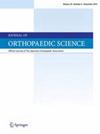肱骨近端屈曲移位骨折的特征和功能预后。
IF 1.5
4区 医学
Q3 ORTHOPEDICS
引用次数: 0
摘要
研究背景本研究的目的是比较肱骨近端骨折患者的骨折特征和功能预后:对325例肱骨近端骨折患者进行了回顾性研究。有初始变曲移位的患者被归入变曲队列,并与无变曲移位的肱骨近端骨折患者按年龄和性别进行1:1配对,称为骨折队列。当初始X光片显示肱骨头的最近端低于大结节的最近端,且头轴角为结果时,即定义为曲折性骨折移位:V队列和F队列各有60名患者。统计分析显示,初始水平偏移(38.8 毫米对 45.9 毫米)、初始前角角度(36.5°对 16.4°)、术后头轴角度(132.2°对 141.3°)、最后头轴角度(122.2°对 138.5°)、头轴角度差异(10.0° vs. 2.7°)、术后水平偏移(43.4 mm vs. 45.3 mm)、最后水平偏移(38.4 mm vs. 42.8 mm)、偏移差异(4.9 mm vs. 2.5 mm)、并发症(15 例 vs. 7 例)和翻修手术(7 例 vs. 1 例)。大多数患者无论是否有屈曲移位,总体上都能获得满意的效果,V组患者的疼痛-VAS评分和Constant评分低于F组。通过接收器操作特征曲线分析,术后头轴角度的临界值为135.5°,这意味着良好/卓越的结果:结论:与最初无曲折移位的骨折相比,曲折移位的肱骨近端骨折伴有水平偏移减小和前倾角增大,并有更多的曲折和水平缩短。曲位移位骨折患者的功能预后较差,这些因素可能会影响功能预后:预后、队列研究,III 级。本文章由计算机程序翻译,如有差异,请以英文原文为准。
Characteristics and functional outcomes of varus displaced proximal humerus fractures
Background
The purpose of this study was to compare fracture characteristics and functional outcomes between patients with proximal humerus fractures with and without initial varus displacement.
Methods
A retrospective review of 325 patients with proximal humerus fractures was performed. Patients with initial varus displacement were placed in Varus cohort and were age- and sex-matched 1:1 with a second cohort presenting proximal humerus fractures without varus displacement, referred to as Fracture cohort. Varus fracture displacement was defined when the most proximal aspect of humeral head was below the most proximal aspect of greater tuberosity on initial radiographs, and the head shaft angle was <130°.
Results
There were 60 patients in V cohort and 60 patients in F cohort. Statistical analysis revealed that there were significant differences in initial horizontal offset (38.8 vs. 45.9 mm), initial anterior angulation angle (36.5° vs. 16.4°), postoperative head shaft angle (132.2° vs. 141.3°), last head shaft angle (122.2° vs. 138.5°), difference for head shaft angles (10.0° vs. 2.7°), postoperative horizontal offset (43.4 vs. 45.3 mm), last horizontal offset (38.4 vs. 42.8 mm), difference for offsets (4.9 vs. 2.5 mm), complications (15 vs. 7 cases), and revision surgery (7 vs. 1 case) between two cohorts. Overall satisfactory results were achieved in most patients regardless of varus displacement, pain-VAS and Constant scores in V cohort were inferior to the scores in F cohort. The cut-off value of postoperative head shaft angle for good/excellent outcomes was 135.5° using receiver operating characteristic curve analyses.
Conclusion
Varus displaced proximal humerus fractures were accompanied by decreased horizontal offset and increased anterior angulation angle, and had a course of more varization and horizontal shortening compared with those without initial varus displacement. Patients with varus displaced fractures were associated with worse functional outcomes, and these factors might affect functional outcomes.
Level of evidence
Prognostic, cohort study, Level III.
求助全文
通过发布文献求助,成功后即可免费获取论文全文。
去求助
来源期刊

Journal of Orthopaedic Science
医学-整形外科
CiteScore
3.00
自引率
0.00%
发文量
290
审稿时长
90 days
期刊介绍:
The Journal of Orthopaedic Science is the official peer-reviewed journal of the Japanese Orthopaedic Association. The journal publishes the latest researches and topical debates in all fields of clinical and experimental orthopaedics, including musculoskeletal medicine, sports medicine, locomotive syndrome, trauma, paediatrics, oncology and biomaterials, as well as basic researches.
 求助内容:
求助内容: 应助结果提醒方式:
应助结果提醒方式:


